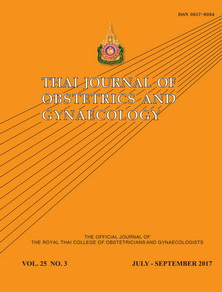Fetal Weight Estimation using Symphysio-fundal Height and Abdominal Girth Measurements in Different Pre-pregnancy Body Mass Indices
Main Article Content
Abstract
Objectives: To study the accuracy of birth weight estimations obtained by multiplying the symphysio-fundal height (SFH) and abdominal circumference (AC) in different pre-pregnancy body mass index (BMI).
Materials and Methods: This cross-sectional study was conducted from April 2015 to September 2015 at two tertiary hospitals. The authors included pregnant women with singleton fetus in vertex presentation with gestational age of 24-42 weeks and intact membranes who expected to deliver within 24 hours after admission. Participants were classified into four pre-pregnancy BMI categories using the criteria for Asian populations. The trained nurses in each hospital measured fundal height starting from the upper border of the symphysis pubis to tip of the uterine fundus, and then the AC was measured at the umbilical level using a measuring tape marked in centimeters. The procedure was conducted during no uterine contraction.
Results: This study recruited 432 pregnant women. Spearman correlation coefficients between fetal weight obtained from multiplication of SFH and AC and actual birth weight in the underweight, normal weight, overweight and obese groups were 0.44, 0.54, 0.59, 0.71, respectively. There was no significant impact of pre-pregnancy BMI on the accuracy rate of birth weight estimation after adjusted for maternal age, parity, and gestational age.
Conclusion: Pre-pregnancy BMI did not significantly affect the accuracy of fetal birth weight estimations obtained by multiplying SFH and AC.
Article Details
References
2. Pay A, Froen JF, Staff AC, Jacobsson B, Gjessing HK. Prediction of small-for-gestational-age status by symphysis-fundus height: a registry-based population cohort study. BJOG 2016;123:1167-73.
3. Challis K, Osman NB, Nystrom L, Nordahl G, Bergstrom S. Symphysis-fundal height growth chart of an obstetric cohort of 817 Mozambican women with ultrasound-dated singleton pregnancies. Trop Med Int Health 2002;7:678-84.
4. Indraccolo U, Chiocci L, Rosenberg P, Nappi L, Greco P. Usefulness of symphysis-fundal height in predicting fetal weight in healthy term pregnant women. Clin Exp Obstet Gynecol 2008;35:205-7.
5. Dare FO, Ademowore AS, Ifaturoti OO, Nganwuchu A. The value of symphysio-fundal height/abdominal girth measurements in predicting fetal weight. Int J Gynaecol Obstet 1990;31:243-8.
6. Mortazavi F, Akaberi A. Estimation of birth weight by measurement of fundal height and abdominal girth in parturients at term. East Mediterr Health J 2010;16:553-7.
7. Farrell T, Holmes R, Stone P. The effect of body mass index on three methods of fetal weight estimation. BJOG 2002;109:651-7.
8. Ben-Haroush A, Yogev Y, Bar J, Mashiach R, Kaplan B, Hod M, et al. Accuracy of sonographically estimated fetal weight in 840 women with different pregnancy complications prior to induction of labor. Ultrasound Obstet Gynecol 2004;23:172-6.
9. Peregrine E, O’Brien P, Jauniaux E. Clinical and ultrasound estimation of birth weight prior to induction of labor at term. Ultrasound Obstet Gynecol 2007;29:304-9.
10. De Reu PA, Smits LJ, Oosterbaan HP, Nijhuis JG. Value of a single early third trimester fetal biometry for the prediction of birth weight deviations in a low risk population. J Perinat Med 2008;36:324-9.
11. Mehdizadeh A, Alaghehbandan R, Horsan H. Comparison of clinical versus ultrasound estimation of fetal weight. Am J Perinatol 2000;17:233-6.
12. Hendrix NW, Grady CS, Chauhan SP. Clinical vs. sonographic estimate of birth weight in term parturients. A randomized clinical trial. J Reprod Med 2000;45:317-22.
13. Kacem Y, Cannie MM, Kadji C, Dobrescu O, Lo Zito L, Ziane S, et al. Fetal weight estimation: comparison of two-dimensional US and MR imaging assessments. Radiology 2013;267:902-10.
14. Hassibi S, Farhataziz N, Zaretsky M, McIntire D, Twickler DM. Optimization of fetal weight estimates using MRI: comparison of acquisitions. Am J Roentgenol 2004;183:487-92.
15. Field NT, Piper JM, Langer O. The effect of maternal obesity on the accuracy of fetal weight estimation. Obstet Gynecol 1995;86:102-7.
16. Fox NS, Bhavsar V, Saltzman DH, Rebarber A, Chasen ST. Influence of maternal body mass index on the clinical estimation of fetal weight in term pregnancies. Obstet Gynecol 2009;113:641-5.
17. WHO Expert Consultation. Appropriate body-mass index for Asian populations and its implications for policy and intervention strategies. Lancet 2004;363:157-63.
18. Preventing and Managing the Global Epidemic Of Obesity. Geneva: WHO, 1997.
19. Aekplakorn W, Mo-Suwan L. Prevalence of obesity in Thailand. Obes Rev 2009;10:589-92.
20. World Health Organization. Global Health Observation Data:Obesity. Available from: http://www.who.int/gho/ncd/risk_factors/obesity/text/en/.
21. Rasmussen KM, Catalano PM, Yaktine AL. New guidelines for weight gain during pregnancy: what obstetrician/gynecologists should know. Curr Opin Obstet Gynecol 2009;21:521-6.
22. Chauhan SP, Hendrix NW, Magann EF, Morrison JC, Kenney SP, Devoe LD. Limitations of clinical and sonographic estimates of birth weight: experience with 1034 parturients. Obstet Gynecol 1998;91:72-7.
23. Tongsong T, Piyamongkol W, Sreshthaputra O. Accuracy of ultrasonic fetal weight estimation: a comparison of three equations employed for estimating fetal weight. J Med Assoc Thai 1994;77:373-7.
24. Baum JD, Gussman D, Wirth JC, 3rd. Clinical and patient estimation of fetal weight vs. ultrasound estimation. J Reprod Med 2002;47:194-8.


